IBPS PO
Q. 1.
Solve the following given question and choose the correct answer

Select the correct answer
A.
Quantity I > Quantity II
B.
Quantity I < Quantity II
C.
Quantity I ≤ Quantity II
D.
Quantity I ≥ Quantity II
E.
Quantity I = Quantity II or No relation
Correct Answer is: B
Q. 2.
Quantity I : Value of ((Sum of single digit positive odd intergers)/(Sum of single digit positive even integers)) Quantity II : Value of ((Sum of cubes of single digit positive odd intergers)/(Sum of cubes of single digit positive even integers))
Select the correct answer
A.
Quantity I > Quantity II
B.
Quantity I < Quantity II
C.
Quantity I ≤ Quantity II
D.
Quantity I ≥ Quantity II
E.
Quantity I = Quantity II or No relation
Correct Answer is: B
Q. 3.
Quantity I : Length of the longest rod that can be put inside a square base box of side 8 cm and height 24 cm. Quantity II : Length of the longest rod that can be put inside a cylindrical box of diameter 10 cm and height 24 cm.
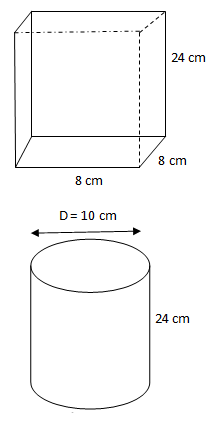
Select the correct answer
A.
Quantity I > Quantity II
B.
Quantity I < Quantity II
C.
Quantity I ≤ Quantity II
D.
Quantity I ≥ Quantity II
E.
Quantity I = Quantity II or No relation
Correct Answer is: A
Q. 4.
A committee of 4 person is to be selected from 5 men and 6 women. Quantity I : Number of ways the selection can be done to include at least 1 women. Quantity II : Number of ways the selection can be done to include at least 1 man.
Select the correct answer
A.
Quantity I > Quantity II
B.
Quantity I < Quantity II
C.
Quantity I ≤ Quantity II
D.
Quantity I ≥ Quantity II
E.
Quantity I = Quantity II or No relation
Correct Answer is: A
Q. 5.
Study the following graph and the adjoining table carefully to answer the questions given below:
-
Graph shows the data regarding per cent of work done in given time by five persons A, B, C, D, and E . A, B, C, D and E are five person employed to complete a job X.
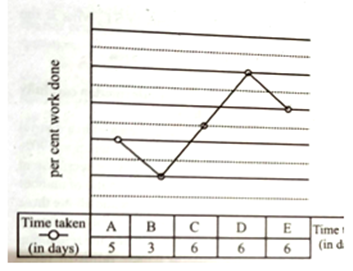
B, D and E worked on job X for 4 days. How many days would A take to finish the remaining job? (in days)
A.
15
B.
12
C.
10
D.
8
E.
6
Correct Answer is: C
Q. 6.
Study the following graph and the adjoining table carefully to answer the questions given below:
-
Graph shows the data regarding per cent of work done in given time by five persons A, B, C, D, and E. A, B, C, D and E are five person employed to complete a job X.
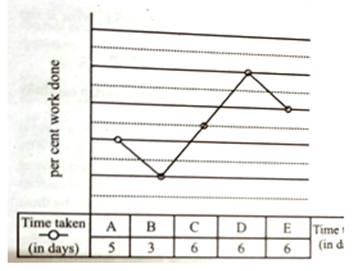
B and E worked on alternate days for 8 days. Then C and D worked together for x days. If of the job still remained incomplete, then find t
A.
4
B.
5
C.
6
D.
7
E.
8
Correct Answer is: B
Q. 7.
Study the following graph and the adjoining table carefully to answer the questions given below:
-
Graph shows the data regarding per cent of work done in given time by five persons A, B, C, D, and E. A, B, C, D and E are five person employed to complete a job X.
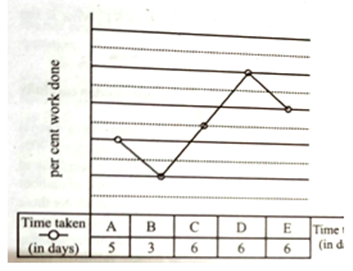
D and E worked together for 5 days and left. The remaining work was complete by C and B working on alternate days starting with C. For how many days did C work? (in days)
A.
10
B.
9
C.
8
D.
7
E.
6
Correct Answer is: E
Q. 8.
Study the following graph and the adjoining table carefully to answer the questions given below:
-
Graph shows the data regarding per cent of work done in given time by five persons A, B, C, D, and E. A, B, C, D and E are five person employed to complete a job X.
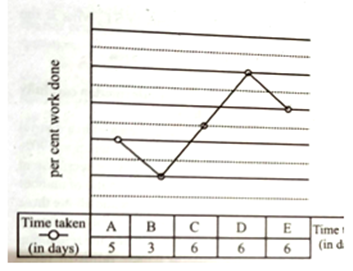
A and D worked together for 5 days. The remaining was completed by C and E. If the ratio of number of days for which C and E worked was 2 : 3, then for how many days did E work? (in days)
A.
3
B.
4
C.
5
D.
6
E.
2
Correct Answer is: D
Q. 9.
Study the following graph and the adjoining table carefully to answer the questions given below:
-
Graph shows the data regarding per cent of work done in given time by five persons A, B, C, D, and E. A, B, C, D and E are five person employed to complete a job X.
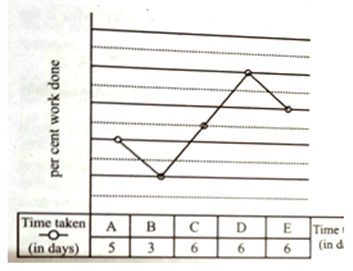
If C worked with times his given efficiency and was assisted by B on every 2nd day and by D on every 3rd day, find the time taken by C to<
A.
12
B.
10
C.
9
D.
8
E.
6
Correct Answer is: A
Q. 10.
ABCD is a square of side 8 cm. PQR is a triangle with side QR equal to the diagonal of the square. ST is the segment joining mid-points of sides PQ and PR of ∆PQR. An isosceles triangle XYZ is drawn right-angled at Y such that the length of the perpendicular YO drawn from Y on hypotenuse XZ equals to ST. What is the area of ∆XYZ? (in sq cm)
Choose the correct answer
A.
128
B.
96
C.
64
D.
32
E.
16
Correct Answer is: D
Q. 11.
Study the information carefully to answer the question that follow :
-
There are 12500 graduates (male + female) in a district who are preparing for various competitive examinations. 90% of these graduates apply for separate exams for recruitment into Railways, Bank and SSC. The respective ratio of number of applicants for only one exam, two exams and all the three exams is 16 : 20 : 9. Of those who applied for only one exam, 12% applied for railways, 26% for Banks and the remaining for SSC. The respective male to female ratios of those applying for only Railways, only Banks and only SSC are 7 : 5, 8 : 5 and 9 : 7 respectively. The total number of applicants for both Railways & Banks and for both Railways & SSC taken together equals that for both Banks & SSC. The number of applicants for both Railways & SSC exceeds that for both Railways and Banks by 100. 60% of those applying for both Bank & SSC are females. The number of males applying for both Railways & SSC is 20% more than for both Railways & Banks which in turn is half of that for both Bank & SSC. The number of female applicants who applied for all the three exams is 665.
What is the overall ratio of male to female applicants for all the exams taken together?
A.
8 : 5
B.
7 : 5
C.
7 : 6
D.
8 : 7
E.
9 : 7
Correct Answer is: D
Q. 12.
Study the information carefully to answer the question that follow :
-
There are 12500 graduates (male + female) in a district who are preparing for various competitive examinations. 90% of these graduates apply for separate exams for recruitment into Railways, Bank and SSC. The respective ratio of number of applicants for only one exam, two exams and all the three exams is 16 : 20 : 9. Of those who applied for only one exam, 12% applied for railways, 26% for Banks and the remaining for SSC. The respective male to female ratios of those applying for only Railways, only Banks and only SSC are 7 : 5, 8 : 5 and 9 : 7 respectively. The total number of applicants for both Railways & Banks and for both Railways & SSC taken together equals that for both Banks & SSC. The number of applicants for both Railways & SSC exceeds that for both Railways and Banks by 100. 60% of those applying for both Bank & SSC are females. The number of males applying for both Railways & SSC is 20% more than for both Railways & Banks which in turn is half of that for both Bank & SSC. The number of female applicants who applied for all the three exams is 665.
What is difference between total number of male applicants for only railways exam and only SSC exam taken together and total number of female applicants for only bank exam and only SSC exam taken together?
A.
270
B.
250
C.
220
D.
200
E.
190
Correct Answer is: E
Q. 13.
Study the information carefully to answer the question that follow :
-
There are 12500 graduates (male + female) in a district who are preparing for various competitive examinations. 90% of these graduates apply for separate exams for recruitment into Railways, Bank and SSC. The respective ratio of number of applicants for only one exam, two exams and all the three exams is 16 : 20 : 9. Of those who applied for only one exam, 12% applied for railways, 26% for Banks and the remaining for SSC. The respective male to female ratios of those applying for only Railways, only Banks and only SSC are 7 : 5, 8 : 5 and 9 : 7 respectively. The total number of applicants for both Railways & Banks and for both Railways & SSC taken together equals that for both Banks & SSC. The number of applicants for both Railways & SSC exceeds that for both Railways and Banks by 100. 60% of those applying for both Bank & SSC are females. The number of males applying for both Railways & SSC is 20% more than for both Railways & Banks which in turn is half of that for both Bank & SSC. The number of female applicants who applied for all the three exams is 665.
The sum of female applicants for only railways and male applicants taking both exams for banks & SSC is what per cent less than the sum of male applicants taking both exam for Railways & Bank and female applicants taking both exam for Banks &am
A.
50%
B.
40%
C.
30%
D.
25%
E.
20%
Correct Answer is: B
Q. 14.
Study the information carefully to answer the question that follow :
-
There are 12500 graduates (male + female) in a district who are preparing for various competitive examinations. 90% of these graduates apply for separate exams for recruitment into Railways, Bank and SSC. The respective ratio of number of applicants for only one exam, two exams and all the three exams is 16 : 20 : 9. Of those who applied for only one exam, 12% applied for railways, 26% for Banks and the remaining for SSC. The respective male to female ratios of those applying for only Railways, only Banks and only SSC are 7 : 5, 8 : 5 and 9 : 7 respectively. The total number of applicants for both Railways & Banks and for both Railways & SSC taken together equals that for both Banks & SSC. The number of applicants for both Railways & SSC exceeds that for both Railways and Banks by 100. 60% of those applying for both Bank & SSC are females. The number of males applying for both Railways & SSC is 20% more than for both Railways & Banks which in turn is half of that for both Bank & SSC. The number of female applicants who applied for all the three exams is 665.
The difference in number of male and female applicants who applied for all the three exams is approximately what per cent of the difference in the total number of male and female applicants?
A.
80%
B.
90%
C.
120%
D.
140%
E.
50%
Correct Answer is: C
Q. 15.
Study the information carefully to answer the question that follow :
-
There are 12500 graduates (male + female) in a district who are preparing for various competitive examinations. 90% of these graduates apply for separate exams for recruitment into Railways, Bank and SSC. The respective ratio of number of applicants for only one exam, two exams and all the three exams is 16 : 20 : 9. Of those who applied for only one exam, 12% applied for railways, 26% for Banks and the remaining for SSC. The respective male to female ratios of those applying for only Railways, only Banks and only SSC are 7 : 5, 8 : 5 and 9 : 7 respectively. The total number of applicants for both Railways & Banks and for both Railways & SSC taken together equals that for both Banks & SSC. The number of applicants for both Railways & SSC exceeds that for both Railways and Banks by 100. 60% of those applying for both Bank & SSC are females. The number of males applying for both Railways & SSC is 20% more than for both Railways & Banks which in turn is half of that for both Bank & SSC. The number of female applicants who applied for all the three exams is 665.
The number of male applicants applying for only two exams is what per cent of total number of male applicants?
A.
35%
B.
42%
C.
45%
D.
48%
E.
50%
Correct Answer is: A
Q. 16. Find the wrong number in the series given below:
- 13, 34, 74, 170, 290, 450,
A.
34B.
74C.
170D.
290E.
450Correct Answer is: E
Q. 17. Find the wrong number in the series given below:
- 7, 28, 61, 121, 211, 377,
A.
28B.
61C.
121D.
211E.
337Correct Answer is: A
Q. 18. Find the wrong number in the series given below:
- 256, 64, 32, 28, 24, 30,
A.
64B.
256C.
28D.
24E.
30Correct Answer is: C
Q. 19. Find the wrong number in the series given below:
- 5, 17, 45, 89, 161, 265,
A.
17B.
45C.
89D.
161E.
265Correct Answer is: B
Q. 20. Find the wrong number in the series given below:
- 7, 20, 45, 68, 115, 150,
A.
20B.
45C.
68D.
115E.
150Correct Answer is: A
Q. 21.
A team of 6 persons is to be selected from a group of 3 men, 3 women and 4 children. What is the probability that it comprises of exactly 2 children?
Select the correct answer
A.
B.
C.
D.
E.
Correct Answer is: D
Q. 22.
Each of the following questions consists of a question followed by information in three statements. You have to study the question and the statements you decide which of the statements is/are sufficient to answer the question.
-
Simple interest earned on that amount at the same rate of interest in 2
years is Rs. 3000.
-
The rate of interest is 5% annum.
-
The principal sum is Rs. 24000
What is the total compound interest earned at the end of 3 years?
A.
only 1
B.
1 & 3
C.
1 & 2
D.
Any two out of the three
E.
All of these
Correct Answer is: D
Q. 23.
Each of the following questions consists of a question followed by information in three statements. You have to study the question and the statements you decide which of the statements is/are sufficient to answer the question.
-
Train A crosses a signal post in 24 seconds.
-
Train A crosses another train B of equal length in 120 seconds. When running in same direction and in 30 seconds when running in opposite directions on parallel tracks.
-
Length of each train is 600 m.
What is the speed of train A?
A.
only 2
B.
1 & 2
C.
1 and either 2 or 3
D.
2 and either 1 or 2
E.
3 and either 1 or 2
Correct Answer is: E
Q. 24.
Each of the following questions consists of a question followed by information in three statements. You have to study the question and the statements you decide which of the statements is/are sufficient to answer the question.
-
Marked price of the article is 40% above its cost price.
-
After 15% discount, the profit earned is 19%.
-
Marked price is Rs. 120 above the cost price.
What is the per cent profit earned at 20% discount?
A.
only 1
B.
only 2
C.
either 1 or 2
D.
1 & 2
E.
All of these
Correct Answer is: C
Q. 25.
Each of the following questions consists of a question followed by information in three statements. You have to study the question and the statements you decide which of the statements is/are sufficient to answer the question.
-
The boat covers a certain distance upstream in 6 hours?
-
The boat covers the same distance downstream in 4 hours?
-
The distance covered is 48 km.
What is the ratio of speed of boat in still water to speed of current?
A.
1 & 2
B.
1 & 3
C.
2 & 3
D.
Any two of the three are sufficient
E.
All the three are necessarily required to answer the question
Correct Answer is: A
Q. 26.
Each of the following questions consists of a question followed by information in three statements. You have to study the question and the statements you decide which of the statements is/are sufficient to answer the question.
-
A, B and C together can do the job in 5 days.
-
A and C together can do the job in 7 1/2
-
Efficiency of A is 5/4 times that of B.
In how many days A alone can do the job?
A.
1 & 3
B.
2 & 3
C.
1 & 3
D.
Any two out of the given three
E.
All the three together
Correct Answer is: E
Q. 27.
Jar A contains 1 litre juice while jar B contains 1 litre water. First, 200 ml of juice is transferred from A to B. Next, 200 ml of mixture is transferred from B to A. If the final ratio of juice to water in jars A and B be m and n respectively, then what is the value of n?
Choose the correct answer
A.
1
B.
C.
D.
E.
Correct Answer is: A
Q. 28.
The length, breadth and height of a hall are in the ratio 5 : 3 : 4. If the length is doubled, breadth increased by 200% and height decreased by 50%, then what is the per cent change in the total surface area of the four walls of the hall?
Choose the correct answer
A.
35.25% increase
B.
24.5% increase
C.
18.75% increase
D.
12.25% increase
E.
6.25% decrease
Correct Answer is: C
Q. 29.
Study the information given in the bar graph and table below carefully and answer the given question.
-
The bar diagram shows the number of candidates who applied for a competitive examination from five states as a percentage of total number of candidates from these states for 2015 and 2016. The table also shows the number of candidates who applied, number of candidates who appeared as percentage of that applied and percentage of candidates who qualified as percentage of those who appeared. Note : Some values are missing in the table indicated by (-). You are expected to calculated the missing value, if it is required to answer the given question on the basis of given information.
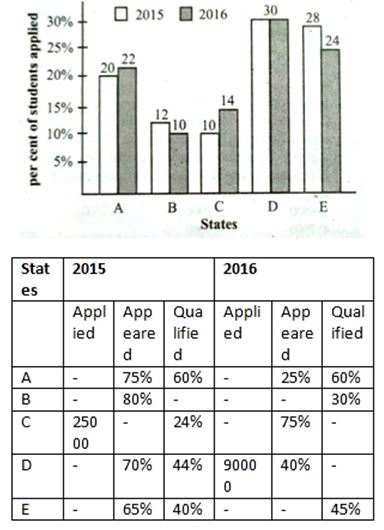
In 2015, if the total number of candidates who appeared in the examination was 182000, then the number of candidates who appeared from state C in 2015 is what per cent of that who applied from the same state and in the same year?
A.
90%
B.
80%
C.
75%
D.
70%
E.
65%
Correct Answer is: A
Q. 30.
Study the information given in the bar graph and table below carefully and answer the given question.
-
The bar diagram shows the number of candidates who applied for a competitive examination from five states as a percentage of total number of candidates from these states for 2015 and 2016. The table also shows the number of candidates who applied, number of candidates who appeared as percentage of that applied and percentage of candidates who qualified as percentage of those who appeared. Note : Some values are missing in the table indicated by (-). You are expected to calculated the missing value, if it is required to answer the given question on the basis of given information.
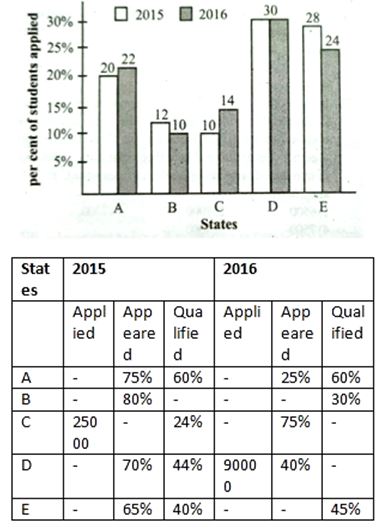
The total number of candidates who applied from all the five states taken together increased by what per cent in 2016 with respect to that in 2015?
A.
30%
B.
25%
C.
22%
D.
20%
E.
15%
Correct Answer is: D
Q. 31.
Study the information given in the bar graph and table below carefully and answer the given question.
-
The bar diagram shows the number of candidates who applied for a competitive examination from five states as a percentage of total number of candidates from these states for 2015 and 2016. The table also shows the number of candidates who applied, number of candidates who appeared as percentage of that applied and percentage of candidates who qualified as percentage of those who appeared. Note : Some values are missing in the table indicated by (-). You are expected to calculated the missing value, if it is required to answer the given question on the basis of given information.
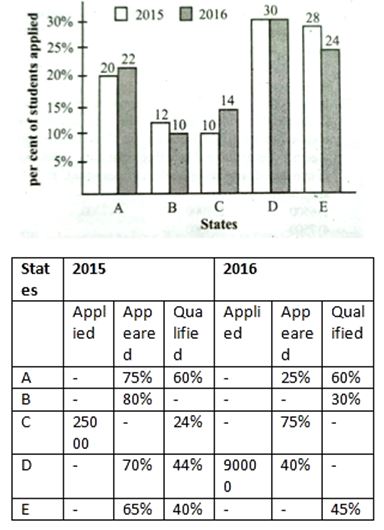
If 55% candidates from state B didn't qualify in 2015 and the respective ratio of number of candidates qualified from State B in 2015 to that in 2016 was 4 : 3, then how many candidates appeared from state B in 2016?
A.
25000
B.
27000
C.
27500
D.
28000
E.
30000
Correct Answer is: B
Q. 32.
Study the information given in the bar graph and table below carefully and answer the given question.
-
The bar diagram shows the number of candidates who applied for a competitive examination from five states as a percentage of total number of candidates from these states for 2015 and 2016. The table also shows the number of candidates who applied, number of candidates who appeared as percentage of that applied and percentage of candidates who qualified as percentage of those who appeared. Note : Some values are missing in the table indicated by (-). You are expected to calculated the missing value, if it is required to answer the given question on the basis of given information.
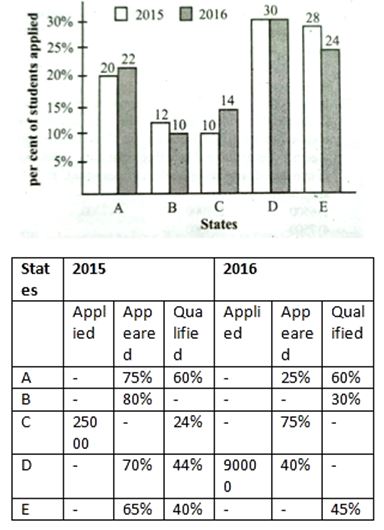
In 2016, the number of candidates who appeared from state D was equal to that from state E. The total number of candidates who qualified in 2016 from states A and B taken together is what per cent of the total number of candidates who appeared from sta
A.
12%
B.
15%
C.
16%
D.
20%
E.
25%
Correct Answer is: E
Q. 33.
Study the information given in the bar graph and table below carefully and answer the given question.
-
The bar diagram shows the number of candidates who applied for a competitive examination from five states as a percentage of total number of candidates from these states for 2015 and 2016. The table also shows the number of candidates who applied, number of candidates who appeared as percentage of that applied and percentage of candidates who qualified as percentage of those who appeared. Note : Some values are missing in the table indicated by (-). You are expected to calculated the missing value, if it is required to answer the given question on the basis of given information.
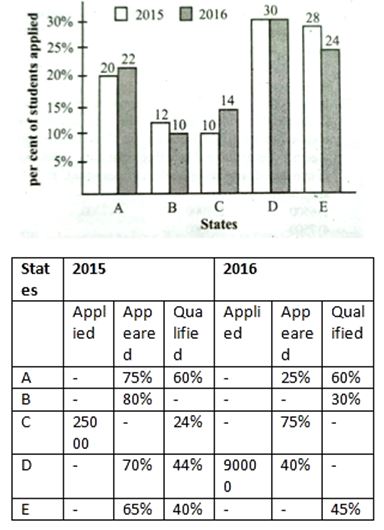
In 2016, the number of candidates qualified from state C and state D were equal. If the total number of candidates qualified from all the five states taken together was 59400 in 2016, then what is the difference in number of candidates qualified from s
A.
6500
B.
7000
C.
7200
D.
7500
E.
8000
Correct Answer is: C
Q. 34. Three persons A, B and C invest capital in the ratio 5 : 4 : 8. After 2 months A withdraws 20% of his investment. One month later B increases his investment by 75%. Further, 2 months later, C makes an additional investment of 25% of his initial investment. At the end of the year if the difference in profit shares of A and B is Rs. 7500, how much does C's profit share exceed that of B?
A.
Rs. 10000B.
Rs. 10500C.
Rs. 12000D.
Rs. 12500E.
Rs. 15000Correct Answer is: B
Q. 35. A boat travels 65km downstream in 6 hrs 30 minutes, when it is travelling in a stream (S1). If this boat travels in another stream (S2) whose speed is 10% more than that of S1 it covers 58 km upstream in 10 hrs. What is the speed of S2? (in km/hr). (Assume the boat's speed in still water in both streams remains the same)
A.
2.2B.
1.5C.
1.8D.
2.4E.
2Correct Answer is: A
Q. 36.
Study the table and answer the given questions.
-
Total number of students in 4 different classes and the percentage of students participating in Dance and Play. Note : The students who participate in Dance do not participate in Play and vice versa.
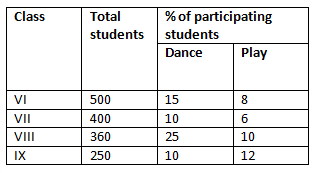
What is the ratio of the no. of students participating in Dance from Class VII and IX together to the no. of students participating in Play from Class VI and VIII together?
A.
43 : 53
B.
65 : 76
C.
44 : 57
D.
63 : 71
E.
62 : 77
Correct Answer is: B
Q. 37.
Study the table and answer the given questions.
-
Total number of students in 4 different classes and the percentage of students participating in Dance and Play. Note : The students who participate in Dance do not participate in Play and vice versa.

What is the average no. of students who participate in Play from all the classes?
A.
32
B.
34
C.
27
D.
35
E.
30
Correct Answer is: A
Q. 38.
Study the table and answer the given questions.
-
Total number of students in 4 different classes and the percentage of students participating in Dance and Play. Note : The students who participate in Dance do not participate in Play and vice versa.
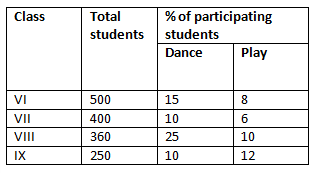
The no. students who participate in Dance from Class VII is what per cent more or less than that who participate in Play from class IX?
A.
12 %
B.
14 %
C.
33 %
D.
16 %
E.
66 %
Correct Answer is: C
Q. 39.
Study the table and answer the given questions.
-
Total number of students in 4 different classes and the percentage of students participating in Dance and Play. Note : The students who participate in Dance do not participate in Play and vice versa.
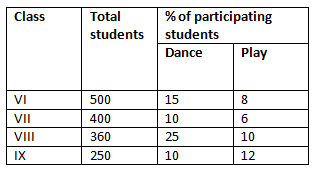
What is the total number of students who do not participate in Dance and Play from class VI and IX together?
A.
720
B.
480
C.
62
D.
580
E.
Other than those given as options
Correct Answer is: D
Q. 40.
Study the table and answer the given questions.
-
Total number of students in 4 different classes and the percentage of students participating in Dance and Play. Note : The students who participate in Dance do not participate in Play and vice versa.
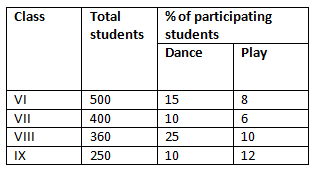
If 20% of students who participate in Dance from Class VI also participate in Play, then find the ratio of the number of students from Class VI who participate only in Dance to that who participate only in Play.
A.
25 : 16
B.
16 : 25
C.
19 : 20
D.
20 : 19
E.
12 : 5
Correct Answer is: E
Q. 41.
Study the table and answer the given questions.
-
Total number of students in 4 different classes and the percentage of students participating in Dance and Play. Note : The students who participate in Dance do not participate in Play and vice versa.
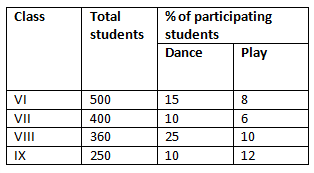
The no. of students participating in Dance from Class VII is what per cent of the no. of students participating in Play from Class IX?
A.
33 %
B.
120 %
C.
114 %
D.
133 %
E.
116 %
Correct Answer is: D
Q. 42.
In the following questions two equations numbered I and II are given. Solve both the equations and give answer
-
x² - 5x + 6 = 0
-
3y² + 3y - 18 = 0
Select the correct answer
A.
if x ≥ y
B.
if x < y
C.
if x ≤ y
D.
if x = y or relationship can't be estabilished
E.
if x > y
Correct Answer is: A
Q. 43.
In the following questions two equations numbered I and II are given. Solve both the equations and give answer
-
x² - 11x + 30 = 0
-
y² - y - 20 = 0
Select the correct answer
A.
if x ≥ y
B.
if x < y
C.
if x ≤ y
D.
if x = y or relationship can't be estabilished
E.
if x > y
Correct Answer is: A
Q. 44.
In the following questions two equations numbered I and II are given. Solve both the equations and give answer
-
2x² + 2x - 4 = 0
-
y² - 5y + 4 = 0
Select the correct answer
A.
if x ≥ y
B.
if x < y
C.
if x ≤ y
D.
if x = y or relationship can't be estabilished
E.
if x > y
Correct Answer is: C
Q. 45.
In the following questions two equations numbered I and II are given. Solve both the equations and give answer
-
x² + 6x - 16 = 0
-
y² - 6y + 5 = 0
Select the correct answer
A.
if x ≥ y
B.
if x < y
C.
if x ≤ y
D.
if x = y or relationship can't be estabilished
E.
if x > y
Correct Answer is: D
Q. 46.
In the following questions two equations numbered I and II are given. Solve both the equations and give answer
-
x² - 4 = 0
-
y² - 9y + 20 = 0
Select the correct answer
A.
if x ≥ y
B.
if x < y
C.
if x ≤ y
D.
if x = y or relationship can't be estabilished
E.
if x > y
Correct Answer is: B
Q. 47.
What approximate value will come in place of question mark (?) in the given questions ? (You are not expected to calculate the exact value.)
-
√80.997 - √25.001 × √120.90 + √16.02 = ?
Choose the correct answer
A.
50
B.
60
C.
75
D.
70
E.
55
Correct Answer is: B
Q. 48.
What approximate value will come in place of question mark (?) in the given questions ? (You are not expected to calculate the exact value.)
-
55.01 - 345.02 ÷ 22.99 = 2 × ?
Choose the correct answer
A.
20
B.
25
C.
22
D.
15
E.
18
Correct Answer is: A
Q. 49.
What approximate value will come in place of question mark (?) in the given questions ? (You are not expected to calculate the exact value.)
-
√(3099.85 ÷ 62.001 + 14.001) = ?
Choose the correct answer
A.
7
B.
8
C.
6
D.
9
E.
5
Correct Answer is: B
Q. 50.
What approximate value will come in place of question mark (?) in the given questions ? (You are not expected to calculate the exact value.)
-
(111.99 × 5) ÷ 14.02 = 11.002 + ?
Choose the correct answer
A.
34
B.
19
C.
39
D.
28
E.
29
Correct Answer is: E
Q. 51.
What approximate value will come in place of question mark (?) in the given questions ? (You are not expected to calculate the exact value.)
-
24.97% of 84.01 ÷ 6.995 = ?
Choose the correct answer
A.
3
B.
4
C.
5
D.
7
E.
6
Correct Answer is: A
Q. 52.
What approximate value will come in place of question mark (?) in the given questions ? (You are not expected to calculate the exact value.)
Choose the correct answer
A.
4950
B.
4820
C.
5520
D.
5340
E.
5260
Correct Answer is: D
Q. 53. The sum of the present ages of A, B, C and D is 76 years. After 7 years the ratio of their ages becomes 7 : 6 : 5 : 8. What is C's present age?
A.
14B.
12C.
13D.
8E.
10Correct Answer is: C
Q. 54. The sum of the length of two trains A and B is 660m. The ratio of the speed of A to that of B is 5 : 8. The ratio of time to cross an electric pole by train A to that by B is 4 : 3. Find the difference between the length of the two trains.
A.
50B.
60C.
80D.
75E.
90Correct Answer is: B
Q. 55.
A mixture of milk and water in a jar contains 28 L milk and 8 L water. x lt. milk and x lt. water are added to form a new mixture. If 40% of the new mixture is 20 lt., then find the value of x ? (in litres)
Select the correct answer
A.
7
B.
8
C.
6
D.
5
E.
3
Correct Answer is: A
Q. 56.
A alone can do a piece of work in 24 days. The time taken by A in completing of the work is equal to the time taken by B in completing
of the work. In what time will A and B together complete the work?
Select the correct answer
A.
9 days
B.
10 days
C.
12 days
D.
48/5 days
E.
8 days
Correct Answer is: D
Q. 57. The marked price of A is Rs. 1600 more than its cost price. When a discount of Rs. 500 is allowed a profit of 25% is earned. At what price should A be sold to earn a 30% profit?
A.
4800B.
5600C.
5400D.
5200E.
5720Correct Answer is: E
Q. 58.
The ratio of the diameter to the height of a right circular cylinder is 4 : 3. If the diameter of the cylinder gets reduced by 25% then its total surface area is reduced to 318.5 square metre. What is the circumference of the base of the original cylinder? (in cm)
Select the correct answer
A.
28 π
B.
14 π
C.
7 √π
D.
7 π
E.
Other than those given as options
Correct Answer is: E
Q. 59. The ten digit of a three-digit number is 3. If the digits at units and hundreds places are interchanged then the number thus formed is 396 more than the previous one. Also the sum of the units digit and hundreds digit is 14. Then what is the number?
A.
480B.
539C.
593D.
935E.
Other than those given as optionsCorrect Answer is: D
Q. 60.
S1 is a series of 4 consecutive even numbers. If the sum of the reciprocal of the first two numbers of S1 is , then what is the reciprocal of the third highest number of S1?
Select the correct answer
A.
B.
C.
D.
E.
Other than those given as options
Correct Answer is: B
Q. 61. A, B and C invested in a business in the ratio of 6 : 8 : 9. B invested for a period whose numerical value is 112.5% of the term of ratio B's investment but A and C invested for one year. If the profit of B at the end of the year is Rs. 16750 then what is the share of the profit of C?
A.
Rs. 20225B.
Rs. 22125C.
Rs. 25225D.
Rs. 25125E.
Rs. 23125Correct Answer is: D
Q. 62.
A boat covers 18 km downstream in 3 hours. If the speed of the current is of its downstream speed, in what time will it cover a distance of 100 km upstream?
Select the correct answer
A.
50 hours
B.
40 hours
C.
30 hours
D.
60 hours
E.
25 hours
Correct Answer is: A
Q. 63.
The ratio of the cost price to the selling price of an article is 5 : 6. If 20% discount is offered on the marked price of the article then the marked price is what per cent more than the cost price?
Select the correct answer
A.
%
B.
50%
C.
40%
D.
%
E.
60%
Correct Answer is: B
Q. 64. Ramesh has 20% savings with him from his monthly salary. If the expenditure on clothing is 25% of overall expenditure and his total expenditure except clothing is Rs. 3600, then find his savings (in Rs. ).
A.
1000B.
1500C.
1600D.
1200E.
900Correct Answer is: D
Q. 65.
Study the bar graph and answer the given questions.
-
Two types of hats sold by Seller A and Seller B on five days:
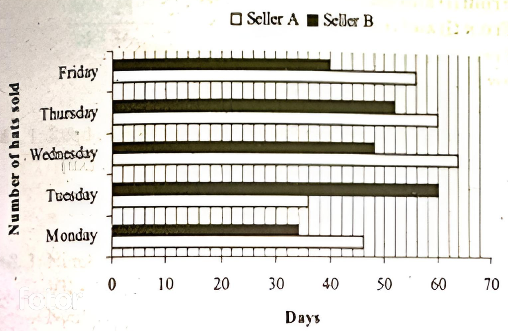
The total number of hats sold by A and B together on Wednesday is what percentage more than the number of hats sold by A and B together on Tuesday?
A.
B.
C.
D.
E.
Correct Answer is: D
Q. 66.
Study the bar graph and answer the given questions.
-
Two types of hats sold by Seller A and Seller B on five days:

If the number of hats sold on Friday by A is increased by 25% then what will be the average no. of hats sold on Monday, Wednesday and Friday by A?
A.
85
B.
58
C.
56
D.
82
E.
60
Correct Answer is: E
Q. 67.
Study the bar graph and answer the given questions.
-
Two types of hats sold by Seller A and Seller B on five days:
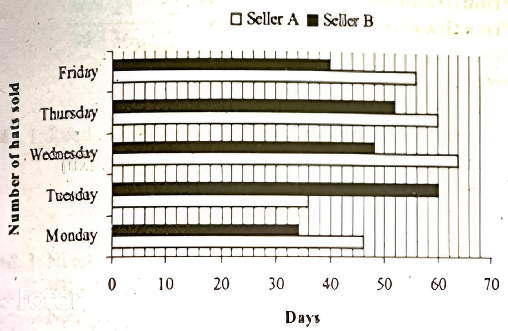
Find the number of hats sold on Saturday by A and B together, if the number of hats sold on Saturday is 7% more than the no. of hats sold on Thursday by A and B together.
A.
110
B.
114
C.
116
D.
118
E.
120
Correct Answer is: E
Q. 68.
Study the bar graph and answer the given questions.
-
Two types of hats sold by Seller A and Seller B on five days:
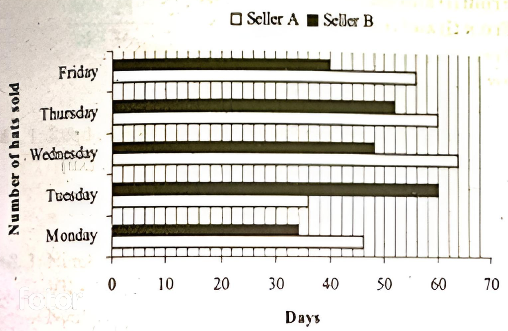
What is the difference between the number of hats sold on Monday and Wednesday by B to the number of hats sold on Friday by both A and B together?
A.
9
B.
12
C.
4
D.
21
E.
24
Correct Answer is: C
Q. 69.
Study the bar graph and answer the given questions.
-
Two types of hats sold by Seller A and Seller B on five days:

A sold 80% defective hats on Thursday and B sold 75% defective hats on the same day. Find the number of hats sold by A and B on Thursday that are not defective.
A.
25
B.
20
C.
18
D.
32
E.
40
Correct Answer is: A
Q. 70.
Study the bar graph and answer the given questions.
-
Two types of hats sold by Seller A and Seller B on five days:
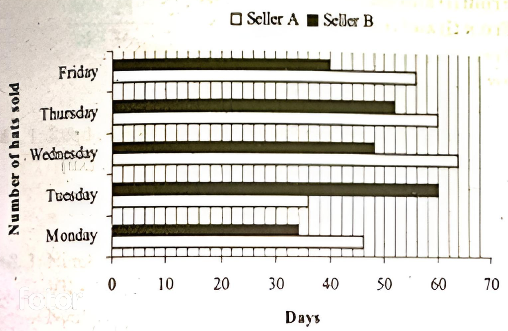
Find the ratio of the number of hats sold by A on Tuesday and Friday together to the number of hats sold by B on the same days.
A.
25 : 23
B.
23 : 25
C.
21 : 25
D.
25 : 21
E.
18 : 17
Correct Answer is: B

 SSC CGL
SSC CGL Insurance
Insurance NABARD
NABARD CAPF
CAPF RBI Assistant
RBI Assistant IBPS PO
IBPS PO SBI PO
SBI PO
